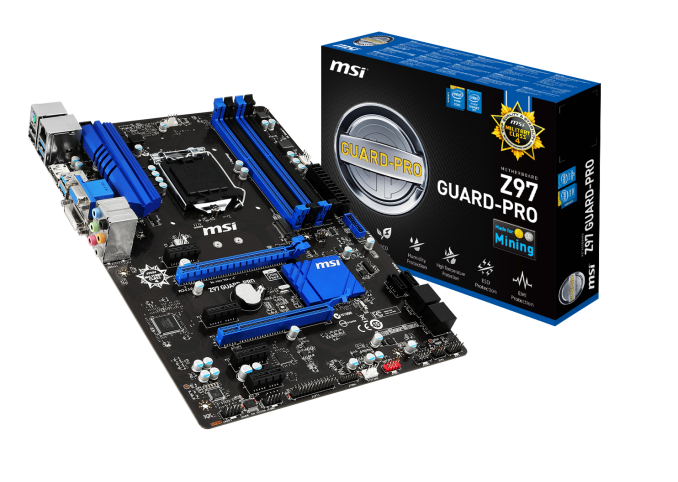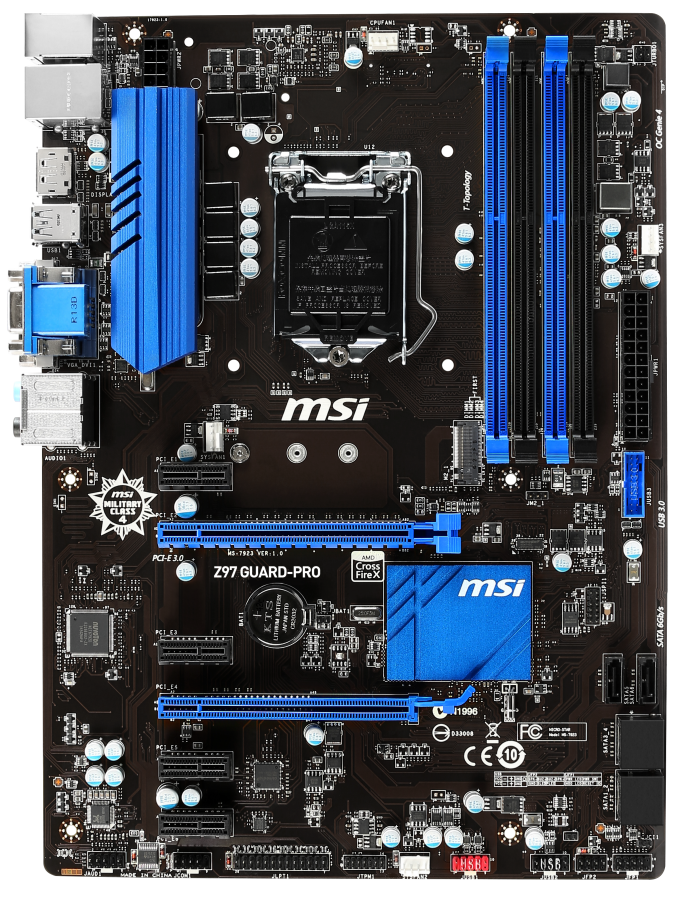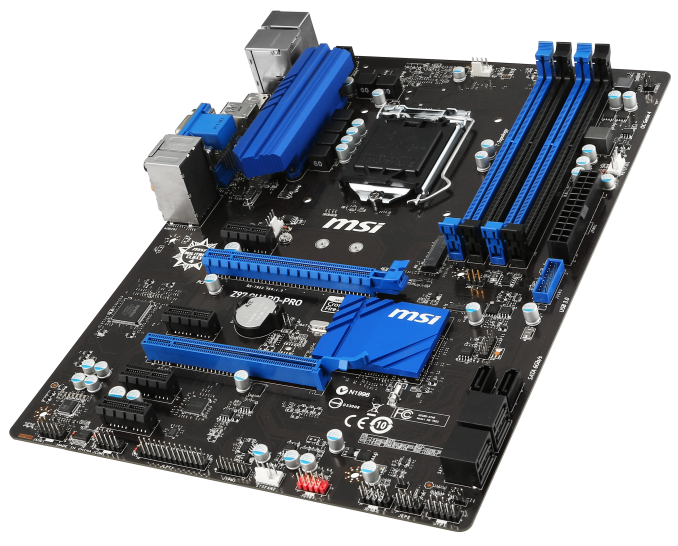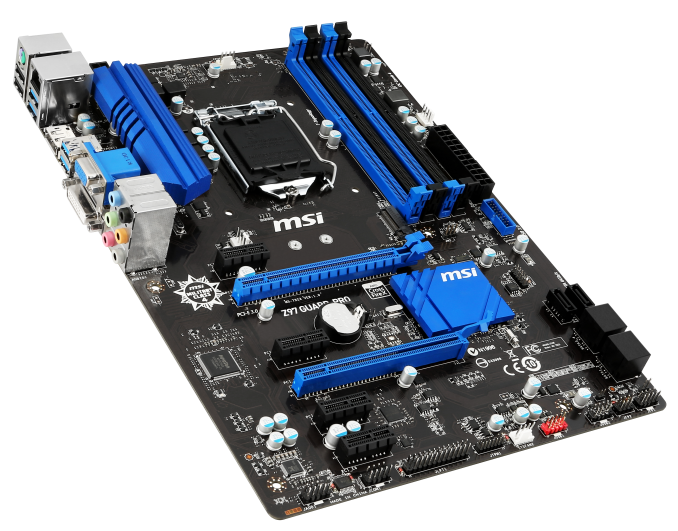MSI Z97 Guard-Pro Review: Entry Level Z97 at $110
by Ian Cutress on August 20, 2014 6:00 AM EST- Posted in
- Motherboards
- Intel
- MSI
- Z97

Next in our recent run of lower cost motherboards is the MSI Z97 Guard-Pro, a motherboard that MSI billed to me as one suited for the overclockable Pentium G3258 on a budget. At $110, we see if it differs much from the more expensive options on the market.
MSI Z97 Guard-Pro Overview
Having had the majority of my reviewing time at AnandTech dealing with motherboards equipped to the hilt, the Z97 Guard-Pro feels quite barren in contrast. The design looks lightweight, with only two full length PCIe slots, four power phases and six SATA ports. The traces on the motherboard between the components and slots also look fewer than the higher end models. Perhaps to reduce the price, this motherboard eschews SLI certification by only having one full PCIe 3.0 x16 from the CPU paired with a PCIe 2.0 x4 from the PCH.
One of the positive things to come from a cheaper end motherboard that still retains a high level chipset is the connectivity, meaning that the six SATA 6 Gbps ports is also paired with an M.2 x2 port and six USB 3.0 ports, one of which is a header. For most users this combination works out well, and the limited bandwidth on the second full length PCIe slot means that a couple of the SATA ports are coming out of the motherboard on the right hand side, which we normally see associated with a low cost product. Another feature for low cost is the combined use of Realtek ALC892 audio and a Realtek NIC which are often both bundled together at a lower than individual unit cost.
MSI is still equipping the board with its Military Class 4 designation, meaning that is passes various military standard tests, but the Guard-Pro element to the design is relatively new. The nomenclature is designed to encompass a series of design elements for increased protection, such as PCB coating for humidity protection (a paint rather than superhydrophobic), each IO port is fused for electrostatic discharge protection, the motherboard complies with FCC regulations for electromagnetic interference (though I would assume almost all motherboards would do) and also ECO Power implemented to allow for lower power operation.
We have covered MSI’s software and BIOS implementations for Z97 several times previously, and the ecosystem as a whole is a definite plus, giving an easy XMP button in the BIOS along with ordered overclock options and graphical fan controls. A couple of negative elements still exist however, such as high voltage selection in Control Center being very easily to implement and we experienced issues trying to get into the BIOS with too low a voltage selected during overclocking without a full BIOS reset.
Benchmark results across the board were in the bottom half compared to most of our other Z97 testing, and the ALC892 dynamic range audio results were lower than expected even for the codec used. DPC Latency was under a hundred which is a plus, with POST times around 12-13 seconds. USB performance was average, but power consumption figures were good for Z97: not ultimately surprising due to the lack of additional features here.
One of MSI’s points about the Z97 Guard-Pro when they shipped me the sample was their aim to make it one of their focus models for Pentium G3258 overclocking, and they provided an extra CPU sample for me to test with. That sample, despite some odd voltage jumps while ramping the frequency, hit 4.8 GHz without any issue with peak temperatures barely touching 80ºC. Despite the four power phases, the Z97 Guard-Pro can withstand a dual core overclocking session for a long-term build.
Visual Inspection
As mentioned above, my first look at this motherboard was one of surprise due to the lack of anything. Perhaps this is due to no power delivery heatsink above the socket and no white outline on the PCB showing where the socket should be. The four power phases for the CPU are to the left of the socket, with the heatsink covering the ICs that generate the heat. For a low cost motherboard, the heatsink is of a decent size which is good to see.
The motherboard has four 4-pin fan headers in white around the motherboard, three within the socket area. The CPU fan header is above the socket, and a 4-pin SYS fan header just above the first PCIe slot. Another SYS header is to the right of the DRAM slots, with the final header at the bottom of the motherboard. Having white fan headers does provide a contrast against the black PCB, although it does perhaps disjoint against the black and blue color of the rest of the motherboard, such as the DRAM slots, PCIe slots, heatsinks and USB 3.0 header.
On the right hand side of the motherboard is the USB 3.0 header, followed by two SATA 6 Gbps ports coming out of the board and four SATA 6 Gbps ports at 90º to the PCB. All six are from the PCH and have full RAID 0/1/5/10 capabilities. At the bottom of the board are the front panel headers, two USB 2.0 headers (the one in red supports fast charging), a TPM header, an LPT header, a COM header and the front audio header. In previous MSI motherboards I have leveraged a criticism that the front panel headers do not guide where the case connectors should be for power/reset buttons, but this motherboard has a printed on guide next to the SATA ports.
The PCIe slots are advertised as being ‘perfect for Bitcoin’, suggesting that all six can be used at once. This would mean that the four PCIe 2.0 x1 slots and PCIe 2.0 x4 slot are all available to use simultaneously, which would use up all eight of the chipset PCIe 2.0 lanes. As mentioned in the overview, this motherboard has a PCIe 3.0 x16/PCIe 2.0 x4 arrangement on the full length PCIe slots which means this motherboard does not support SLI with NVIDIA graphics cards. Crossfire is possible but the bandwidth restriction on that PCIe 2.0 x4 slot might not provide the maximum FPS gain desired by adding a second GPU.
The rear panel is slightly shifted compared to most other Z97 motherboards with the network port nearer the top of the motherboard and the D-Sub/DVI-D port lower down. Aside from these, the rear panel also houses a combination PS/2 port, two USB 2.0 ports, four USB 3.0 ports, a DisplayPort and the audio jacks. Having a DisplayPort on the motherboard rather than a HDMI seems odd, though it might save costs based on HDMI licensing.
Board Features
| MSI Z97 Guard-Pro | |
| Price | US (Newegg) |
| Size | ATX |
| CPU Interface | LGA-1150 |
| Chipset | Intel Z97 |
| Memory Slots |
Four DDR3 DIMM slots supporting up to 32 GB Up to Dual Channel, 1066-3300 MHz |
| Video Outputs |
DisplayPort (4096x2304 at 24 Hz, 3840x2160 at 60 Hz) VGA (1920x1200 at 60 Hz) DVI-D (1920x1200 at 60 Hz) |
| Onboard LAN | Realtek RTL8111G |
| Onboard Audio | Realtek ALC892 |
| Expansion Slots |
1 x PCIe 3.0 x16 1 x PCIe 2.0 x4 4 x PCIe 2.0 x1 |
| Onboard SATA/RAID | 6 x SATA 6 Gbps, RAID 0/1/5/10 |
| USB 3.0 | 6 x USB 3.0 [4 rear panel, one header] |
| Onboard |
6 x SATA 6 Gbps 1 x USB 3.0 Header 2 x USB 2.0 Headers 4 x Fan Headers 1 x TPM Header 1 x LPT Header 1 x COM Header Front Panel Headers Front Audio Header |
| Power Connectors |
1 x 24-pin ATX 1 x 4-pin CPU |
| Fan Headers |
1 x CPU 4-pin 3 x SYS 4-pin |
| IO Panel |
1 x Combination PS/2 Port 2 x USB 2.0 Ports 4 x USB 3.0 Ports VGA DVI-D DisplayPort 1 x Reatek NIC Audio Jacks |
| Warranty Period | 3 Years |
| Product Page | Link |
The Z97 Guard-Pro totally makes sense from the point of view of a compute platform that does not rely on PCIe bandwidth. MSI is promoting all of its protection features along with 6-way PCIe device supportand enough horsepower with an overclocked G3258 to organize the data. Note that the decision to use DVI-D, VGA and DisplayPort on the rear means that users can equip three screens from the processor graphics without issue.















41 Comments
View All Comments
wetwareinterface - Thursday, August 21, 2014 - link
It's assumed, if you're an enthusiast, you are upgrading your system to something in a medium priced offering that gives great bang for buck value with overclocking (i5/i7 k series paired with r9 290/780 dual xfire/sli), or are spending gobs of money to hang your ass over the bleeding edge (xtreme edition, socket 2011, quad sli titan z / crossfire 295x etc..). Enthusiast class hardware isn't on the low end of pentium or i3 even unless they are building an HTPC or a box for mom to surf on.austinsguitar - Wednesday, August 20, 2014 - link
okay do yourself a favor and buy a 120 dollar motherboard (10 dollars more.) anandtech... you keep disapointing me with these articles. for 120 you can get m.2 and sata express, sli, intel lan, and realtek 1150.... just look it up people. i dont know what anandtech is thinking these days...austinsguitar - Wednesday, August 20, 2014 - link
gigabyte z97x-sli. look it upDeath666Angel - Friday, August 22, 2014 - link
"i dont know what anandtech is thinking these days..."Probably thinking that they are reviewing the products they get sent by the manufacturer. As always. You could say the same thing. You really don't need a big board to OC on Haswell. I have a AsRock Z87M Pro4 which I bought because it was the cheapest mATX 1150 board and I used it with a Pentium for my Litecoin mining machine. Now that fad is over I bought a 4770k and upgraded my aging i7-860 system with it. Am reaching 4.5GHz comfortably so far. It even has an Intel NIC.
Samus - Thursday, August 21, 2014 - link
Is this board the same as the Z97 PC Mate (with the addition of the M2 slot?) Looks almost identical.Shadowmaster625 - Thursday, August 21, 2014 - link
No its not the same as the Z97 PC Mate. I believe the Z97 PC Mate is better, since it gives a 100mhz better ocSamus - Thursday, August 21, 2014 - link
How is the PC Mate better when it doesn't have M.2? The 100Mhz+ OC doesn't make sense to me...they both have 4-phase power and even the BIOSes are updated identically on MSI's site. Interestingly, though, the PC Mate uses an Award BIOS and the Guard-Pro uses an AMI.http://us.msi.com/support/mb/Z97_PC_Mate.html#down...
http://us.msi.com/support/mb/Z97_GUARDPRO.html#dow...
These boards are similar enough to get the same BIOS development.
wavetrex - Friday, August 22, 2014 - link
Why even bother putting "mining" in the article ? PC coin mining is dead.The difficulty has gone up so much due to all the ASIC's and FPGA's and simply TOO MANY people mining, that even with the most power efficient GPUs, you still end up losing money, electricity costing more than the tiny amounts that a PC is able to mine.
Time to move on people, the scam is complete.
RegorTejmar - Monday, August 25, 2014 - link
The 4 PCIe X1 ports only use a single lane from the Z97 chipset. The connect them via a ASM1184 Hub/switch. The Z97 has 18 high speed IO slots. This Motherboard uses 6 USB 3.0, 4 PCIe to the 2nd x16 Slot, 1 PCIe to the ASM1184 (powering the 4 x1 slots), 1 PCIe for the Realtek LAN, and 2 that are either M.2 or SATA and 4 that are SATA.KAlmquist - Tuesday, August 26, 2014 - link
So what happens to EIST when you overclock with this board? With schemes like EIST, the operating system adjusts the core frequency based on load. At lower frequencies the cores run at a lower voltage, which increases efficiency (performance per watt).On the Asus Vanguard B85 motherboard, which has a BIOS that looks suspiciously like the one on the MSI motherboard being reviewed, EIST stops working if you overclock. The core frequencies will still change like they are supposed to, but the core voltage no longer decreases when the frequency decreases, which defeats the purpose of EIST.
I would add that, if you have done a significant overclock, there is a chance that the maximum voltage you have chosen is one that will cause your CPU to degrade slowly over time. In that case, you certainly don't want to have the CPU operating at that voltage when you are doing nothing more demanding than typing comments on the Anandtech web site.
So it would be really nice to know if the problem I describe is specific to Asus or whether MSI has the same problem.